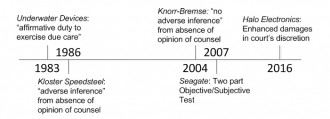February 9, 2017
Enhanced Damages for Willful Infringement
Proving willful patent infringement became easier after the Supreme Court in Halo rejected the rigid two-part Seagate test for willful infringement, thereby removing a significant hurdle to an award of enhanced damages. In evaluating whether conduct was willful, a court should consider culpability at the time of the challenged conduct rather than at the time of trial. Infringement defendants can no longer rely solely on reasonable litigation-inspired defenses to prevent a finding of willfulness. It may be appropriate to revisit opinion practice to avoid willful infringement and possible treble damages. For example, it may be beneficial to obtain freedom to operate opinions prior to or at the time of commercialization.
35 U.S.C. § 284 provides for enhanced damages in a case of willfulness when a patentee wins a judgment for infringement, stating that “the court may increase the damages up to three times the amount found or assessed.” Courts have previously evaluated whether infringing conduct was willful under the Seagate test, which required a patentee to show by clear and convincing evidence that: (1), the infringer acted “despite an objectively high likelihood that its actions constituted infringement of a valid patent”; and (2), the risk of infringement “was either known or so obvious that it should have been known to the accused infringer.”
In Halo, the Supreme Court unanimously rejected the two-part Seagate test for willfulness under § 284 as “unduly rigid.” The Court found that the test “impermissibly encumbers the statutory grant of discretion that statute gives to the district courts.” It also rejected the “clear and convincing” evidence standard in favor of a lower “preponderance of the evidence” standard. Under Halo, a patentee can recover enhanced damages under § 284 if it shows by a preponderance of the evidence that the infringer engaged in “egregious” activity “beyond typical infringement.”
The Federal Circuit applied the more flexible Halo standard in WBIP to affirm the district court’s award of enhanced damages where the infringer had knowledge of the patents-in-suit. The court noted that under Halo, the appropriate time frame for assessing culpability is at the time of the challenged conduct rather than at the time of trial.
Takeaway: Under Halo, it will be easier for patent owners to avoid Summary Judgment on an issue of willfulness without proving both: (1) objective recklessness; and (2) subjective knowledge by clear and convincing evidence. Infringement defendants can no longer rely solely on reasonable litigation-inspired defenses to prevent a finding of willfulness. Thus, a company that is aware of competitor patents that arguably cover its products should consider a freedom to operate review.
Citation: Halo Electronics Inc. v. Pulse Electronics Inc., 118 USPQ2d 1761 (U.S. 2016); WBIP, LLC v. Kohler Co., 119 USPQ2d 1301 (Fed. Cir. 2016)




































